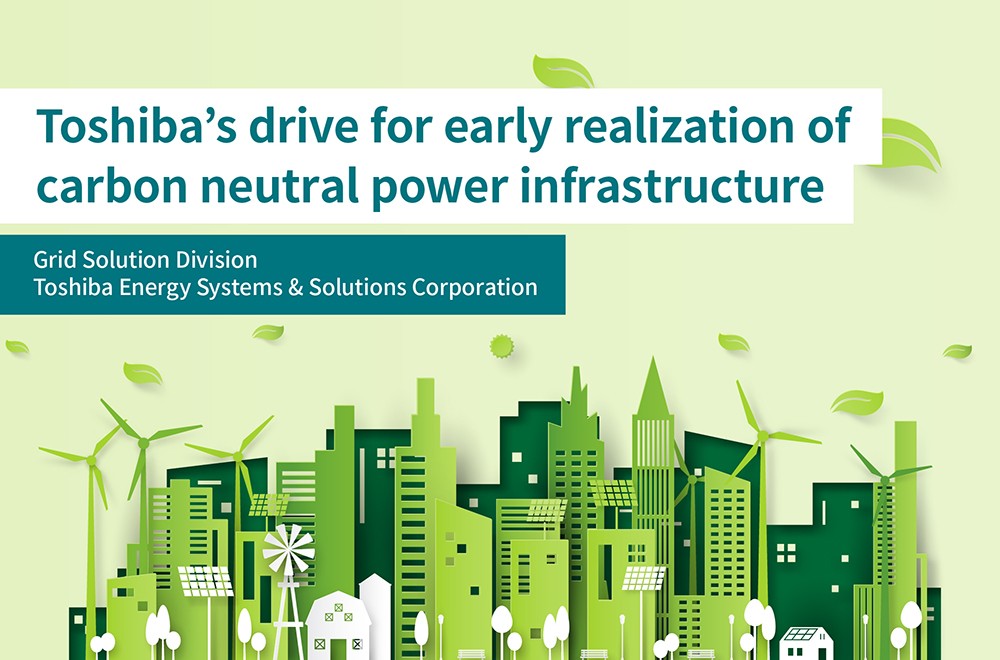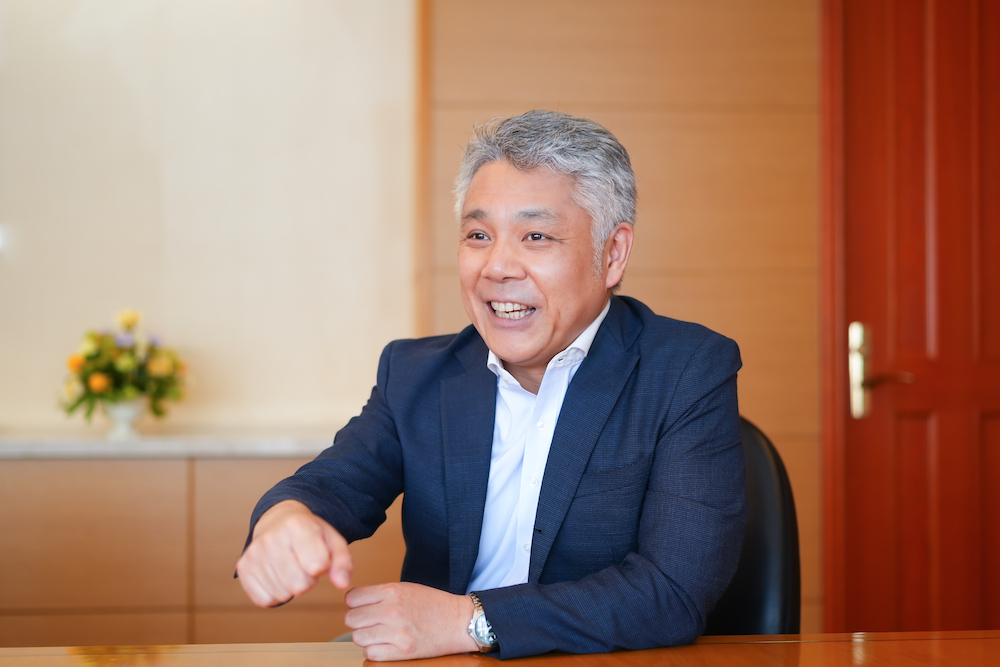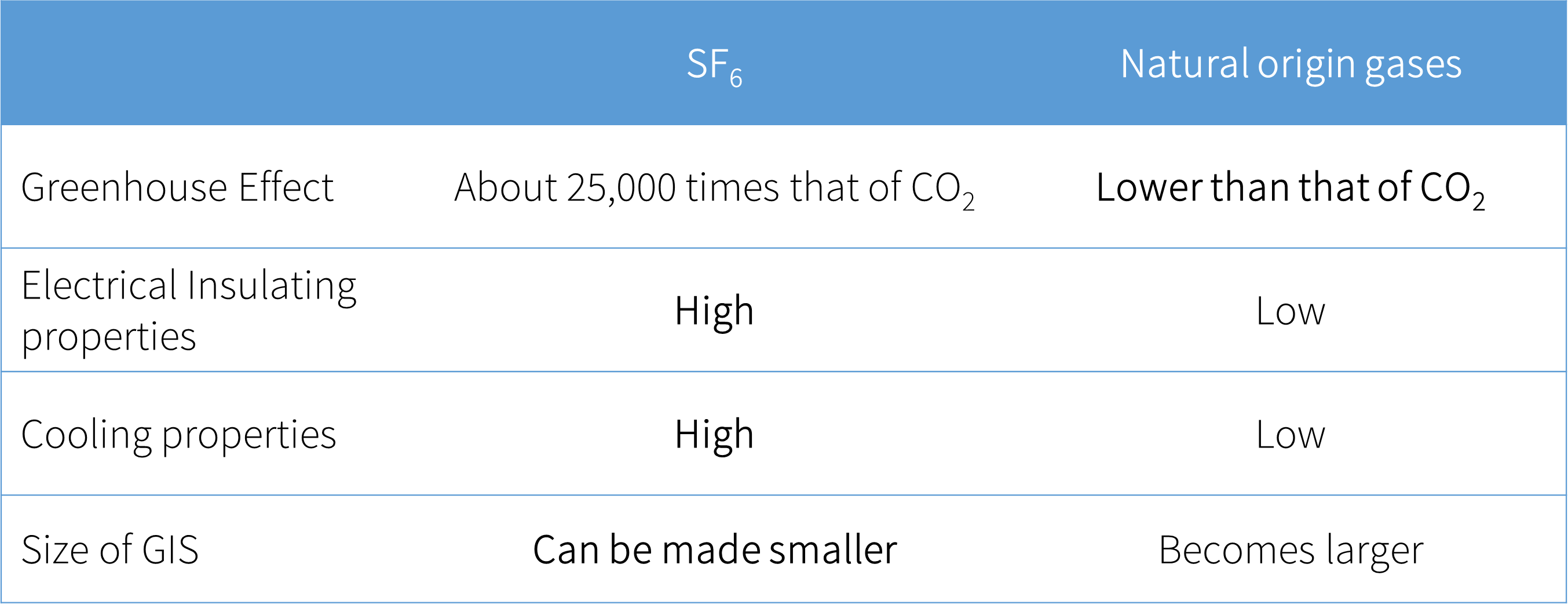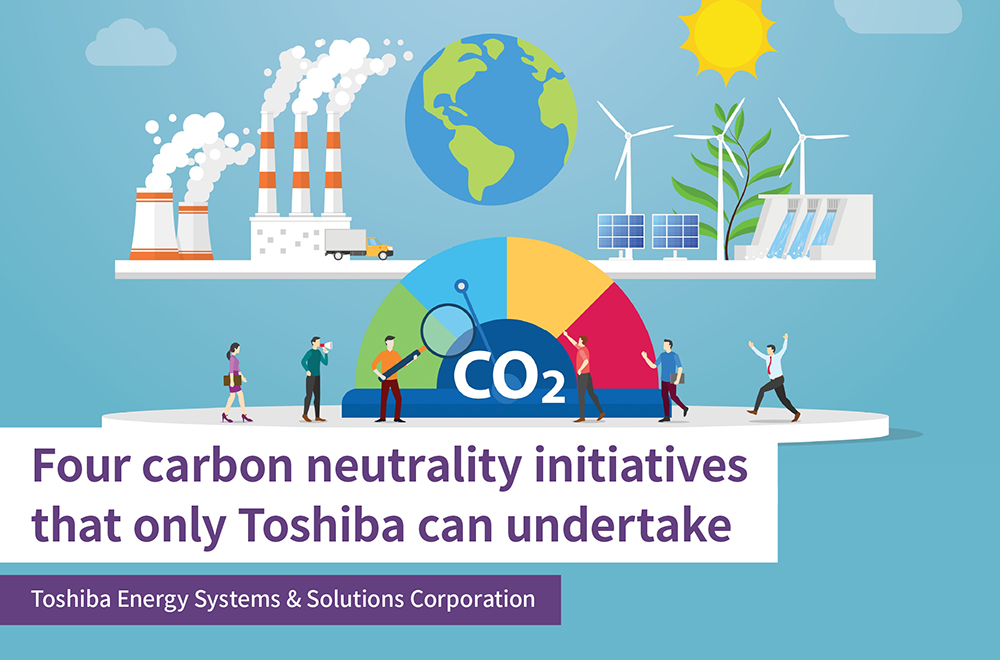Toward Sustainable Electric Power Infrastructure, Part 1 -Can We Eliminate Greenhouse Gases from High-Voltage Power Transmission Equipment?
2023/02/17 Toshiba Clip Team
- Why is GIS an essential part of electric power infrastructure?
- Toshiba’s new equipment uses gases with lower greenhouse effect than CO₂
- Going all out for carbon-neutral power infrastructure

In summer 2022, for the first time in its history, London recorded a temperature of over 40-degrees Celsius. In Japan, torrential rains that trigger natural disasters are increasing in scale and intensity. Some parts of the world face drought, but other regions have been hit with severe flooding, and familiar weather patterns are giving way to increasingly severe weather events. In 2021, the IPCC*1 reported, “Human-induced climate change is causing dangerous and widespread disruption in nature and affecting the lives of billions of people around the world.” For many of us, as we see and read more and more news reports of abnormal weather and the damage it causes, this is a problem that draws ever closer.
*1 IPCC: the Intergovernmental Panel on Climate Change. It organizes, collates and reports on research into global warming.
Climate change is strongly driven by increases in greenhouse gases in the atmosphere that are warming the planet. CO₂ is familiar to all of us, but there are others, including sulfur hexafluoride, SF₆, which is almost 25,000 times more potent at trapping heat than CO₂. SF₆ is used in gas insulated switchgears (GIS), an essential part of electric power infrastructure, and there is now a worldwide race to develop and switch to a different alternative gas.
One way forward is to replace SF₆ with natural origin gases. But the feasibility of this has long been questioned. In this two-part article we look at attempts to develop a new eco-friendly GIS that meets this challenge and assures stable operation of power transmission infrastructure, starting with a brief explanation of what GIS is and what it does.
GIS is an essential part of electric power transmission infrastructure
GIS basically acts as a switch to turn electricity flows on and off. It is installed in power transmission substations in the electricity transmission and distribution network, the power grid. It takes advantage of the high electrical insulating performance of SF₆ gas (gas insulation) to immediately cut the power in the event of a sudden voltage surge or an abnormal power flow triggered by a lightning strike and so forth. The GIS safely disconnects the substation from the power grid, protecting stable supply and the power infrastructure. An indispensable part of the power transmission network, because of the way it can switch the transmission route and control the power system, GIS is also installed in railroads, factories, and other facilities that require a large, stable power supply. GIS ensures we can use electricity with peace of mind and rely on the stable operation of trains and facilities.

The role of GIS in power distribution
A GIS houses circuit breakers, disconnectors, surge arresters, and other equipment in a metal tank filled with SF₆ gas. Although its atmospheric warming characteristics are well known, SF₆ has excellent insulating properties and unmatched strength in switching large power flows on and off. It is also a chemically stable, non-toxic and odorless gas, and easy to handle, other than for the need for careful control to prevent its release into the atmosphere. All this has earned SF₆ wide application since the 1960s, and in recent years demand has increased for applications other than GIS, such as cover gas to prevent oxidation in melting furnaces and the dry etching processes for semiconductors and LCDs. However, SF₆ has a very long atmospheric life*2 of 3,200 years*3, and once it is released into the atmosphere, its heat retention effect has a cumulative effect on warming.
*2 The time constant of decay: the time required for the concentration in the atmosphere to decrease to approximately 37% of its initial level.
*3 IPCC, 2021
Toshiba commercialized Japan’s first GIS in 1969, and used SF₆ to do so. Since then, many electric power companies have relied on Toshiba-made GIS to ensure stable power supply, and the company is the leader in Japan’s electric power market. In addition to equipment for large-scale substations and power plants, Toshiba also offers compact SF₆ GIS that can be installed in underground substations in buildings and commercial facilities, delivering behind-the-scenes support for stable energy supply in urban centers. Overseas, Toshiba competes with other major manufacturers, mainly European ones.
Zero greenhouse effect! Japan’s first GIS for electric power using natural origin gases
On July 12, 2022, Toshiba announced the development of a 72/84 kV GIS that uses natural origin gases, and the receipt of its first order, from TEPCO Power Grid, Inc. The GIS replaces conventional SF₆ with dry air, a mixture of nitrogen and oxygen that is safer and that does not contribute to global warming itself. Interest in the announcement was high, and an audience of over 500 people saw the joint presentation with Meidensha Corporation, Toshiba’s partner in the GIS’s co-development. Questions came from people in a range of fields, including power utilities, companies in the electricity business, and academia.
One man watching the packed presentation with more emotion than most: Toshiyuki Uchii of Toshiba Energy Systems. Uchii joined Toshiba 25 years ago, in 1997, and has long specialized in GIS research and development.

Toshiyuki Uchii, Fellow, Power & Substation Systems Engineering Dept., Grid Solution Div.,
Toshiba Energy Systems & Solutions Corporation
For all of SF₆’s advantages in ensuring substation safety and stable power supply, questions are increasingly being asked about its use. In a world making determined moves to counter the growing impacts of climate change by promoting carbon neutrality, the simple fact that SF₆’s greenhouse effect is almost 25,000 times that of CO₂ is a cause for concern, and has triggered moves to legal restriction of its use, most notably in Europe and the United States.
For over 15 years Uchii researched the question of how to replace SF₆—starting at a time when interest in global warming was nowhere near as high as it is today. The unveiling of the new GIS was the moment when his years of work finally came to fruition. It also marked an important opportunity for Toshiba to show the world that it was possible to replace SF₆ with natural origin gases—and a new step toward carbon neutrality for electric power transmission and distribution infrastructure.
Toward development of GIS using alternatives to SF₆
Let’s rewind time a little. In 1997, the United Nations Framework Convention on Climate Change adopted the Kyoto Protocol, which required both emerging economies and the developed economies to cut greenhouse gas emissions. SF₆ was one of the restricted gases designated as a target for reduction, and this triggered efforts around the world to cut its emissions.
Japan adopted the Closed Cycle Concept, a focus on minimizing leaks of SF₆ of power equipment while still making use of its special characteristics. As a result, SF₆ has been strictly managed, and properly collected and recycled. Emissions declined significantly in the 2000s, and by 2005 the industry had achieved its voluntary reduction target, along with its goals of preventing any leaks SF₆ into the atmosphere during GIS production and operation, and proper disposal of the gas when recycling became difficult.
Looking back on this, Uchii says, “With GIS, SF₆ is filled into a sealed tank, so basically it does not leak into the atmosphere, and its collection and recycling is strictly controlled during equipment maintenance and inspection. However, all those requirements lead to additional labor and costs, and I wondered if we could somehow achieve a GIS that did not use SF₆…” So how did Uchii handle this problem?

Stay ahead of its time and tackle difficult problems head-on
While developments of GIS was still based on SF₆ gas, Uchii promoted research on alternative gases in his laboratory. He was the first to point out in technical papers and other publications that natural origin gases, such as nitrogen, oxygen and carbon dioxide, are the only suitable alternatives to SF₆ for electric power applications, “in respect of toxicity, boiling point, stability, and environmental compatibility.”
Of course, it is not that simple. The electrical insulating capability of natural origin gases is only about a third of that of SF₆, so a large volume of gas is necessary to secure a comparable performance. On top of that, SF₆ also delivers excellent current interruption, and achieving the same level of performance with a GIS loaded with natural origin gases is another major issue. The cumulative result is unavoidable: larger GIS and higher costs. These conflicts ended up with a situation where consideration of alternative gases for GIS stayed at the research level.

Natural origin gases have lower insulating and cooling properties than SF₆, and larger GIS size is also an issue
In the mid-2010s, however, the tide turned dramatically. In Europe and the United States, moves to regulate use of SF₆ in electric power equipment gained momentum. Both in Japan and overseas, there was a change in perspective on using alternative gases, and there was a shift toward putting Uchii’s research to practical use.
Uchii recalls when this came home to him: “In 2014, I attended a major conference in France, and it convinced me that in the near future the GIS business would have to consider a new factor in competition: the environment. To be completely honest, I felt that there was no future for Toshiba’s GIS unless we developed equipment that did not use SF₆. Above all else, it was crystal clear that a GIS without SF₆ was vital for achieving carbon neutrality in power transmission and distribution infrastructure.
“Even so, I still wondered whether it was really possible to create something that could truly replace conventional products without using SF₆, a gas with outstanding performance. It was self-evident that it would be an extremely difficult technological challenge. But I could also see that, if we could do it, it would have an impact that would completely redraw the power structure. If we could come out with a real alternative technology, one that really provided the same functionalities but without SF₆, customers would happily choose it. When I thought about that, it really fired me up as a GIS engineer.”
It can be said that Toshiba has been able to stay ahead in technological development because it has continued to carry out research from a long-term perspective. In part two of this article, we will look at the development process for the new SF₆-free GIS, now put to practical use thanks to the hard work of a team of Toshiba engineers.
![]()
Related Links
*This section contains links to websites operated by companies and organizations other than Toshiba Corporation.
TOSHIBA AEROXIA Brandbook
Transmission & Distribution | Toshiba Energy Systems & Solutions







